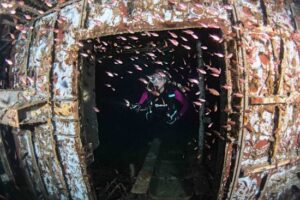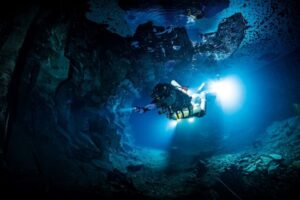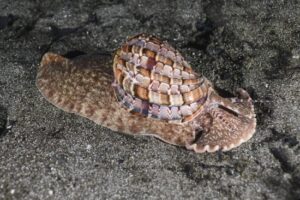Wide angle photography is difficult to master. Small details make all the difference, it can take years of practise, some days you will nail your shots and others you will wish you never took up photography. Perseverance is key, don’t give up and most importantly, when you think you are close enough, get closer!
This saying has stuck with me my whole photography career, and it’s a technique that I have based my style upon. I love shooting wide. Done correctly you can get some truly jaw dropping images that really do make the viewer feel like they are there with you out in the deep blue sea. When shooting wide angle, anything bigger than a football can be considered an ideal wide angle object.
So why get closer?
Technically speaking, reducing the amount of water between your camera and the subject is great for the quality and clarity of your images. The further away you are from the subject, the more colour and light you lose. A water column that is dense and full of particles will distort your image and take away colour and clarity, leaving your images with a green blue hue. The further away from the subject you are, the more this increases, so get close.
Not only does it help make the subject the main focus, getting close also improves an image’s crispness and vibrancy – this is what makes wide angle photography so appealing.
The nature of the wide angle lens, whether that of a fisheye or rectilinear zoom, is that it creates separation between the subject and the photographer, which is why we say get close. Many of my best shots are mere centimetres from the dome and at the widest possible focal point.
F8 and be there!
As mentioned earlier, if you want to shoot an eye catching underwater image, you need to get close and manipulate your settings depending on the conditions. I start at f/8 ISO 100 and around 1/125th shutter speed. If the subject is skittish, I may open the aperture to f/5.6. If visibility is poor, I will increase my ISO. This all depends on the natural light that is accessible at the time.
If I want to control the colour of the water in the background, I can increase or decrease my shutter speed. All this takes time to master. Many hours spent in the water practising means that when you finally get the opportunity, you will know what is required to get “that shot”.
It is critical to note that the subject really is the main subject. A good background is important and makes for better images, but your foreground and main subject is key. Ensure it takes up a large portion of the image. The sun is also really good for positioning subjects against. Close down your shutter if the sun is blown out and get close.
Don’t be annoying
To get a good shot, the animal should be calm and not showing signs of erratic behaviour. The big mistake people make is chasing animals down, don’t do this! Instead, spend time in the water, give them their space, and as they get used to you being in their habitat they will come to you, don’t go to them. This can be difficult as all you want to do is try and get the shot, but from my experience, patience is rewarded!
A good photographer knows when their subject has had enough, just like human models on land. The more relaxed they are, the better your photos will be.
Wide, wider, wider!
Wide angle lenses are the way to go when getting close. When we talk about wide angle, there are two main lenses that come to mind. The first is a fisheye or Ultra-wide angle. This is a view of nearly 180 degrees crammed into an image. Because of this, there is major distortion and no lines are straight. Some photographers don’t like this, but personally I love it and shoot almost solely with a fisheye. If you are not a fisheye fan, then the rectilinear wide angle is your other option, simply another name for a wide angle lens, they usually start at about 10mm. All lines will be straight with minimal distortion creating a nice straight, clean image. When starting out, it’s good to try both and see what you like best.
Get trigger happy
Don’t stop shooting. Once, twice, ten times – shoot as much as you want, it doesn’t matter. We live in an amazing digital world where, if we wanted to, we could take 5000 photos with no problems at all. The underwater world is dynamic, things are moving and changing constantly, so shooting lots will improve your chances of nailing the shot. Of course, once you are more experienced, you can work on timing your shots using skill rather than just the camera’s incredible speeds. Remember, practice makes perfect.
Practise makes perfect
I spent a lot of time shooting rocks when I was starting out, objects that don’t move are far easier to shoot than ones that do, so practise. Coral, sponges, seaweed, plants and seafloor features are perfect for practising on. Once you have learnt by trial and error and have mastered your camera settings, shooting moving objects will become a lot easier.
Safety
The final and most important concept is your own safety. Dealing with small creatures is fine, but a shark or whale can be dangerous, so it is very important to use good judgement. Don’t be chasing animals around, they could feel threatened and turn and react. Don’t corner creatures or block their exits, treat all animals with respect, and if they are becoming agitated, move on.
If you are scuba diving, keep an eye on your air, bottom time and your buddy. Photographers get distracted easily, and before you know it you could be deep and running out of air. This is why it is so important to be a competent diver BEFORE getting into photography.
Don’t forget to have fun!
Diving is fun, photography is fun, the two combined is a heap of fun, but I see a lot of photographers getting annoyed, upset and frustrated because they are not getting the shot they were after. Keep it simple and enjoy the process, shoot as much as you can and learn every time you go out. In time, you will start coming home with “the shot”!
The post Get close and then get closer! Underwater photography tips with Dan appeared first on Mares – Scuba Diving Blog.
Read MoreDiving, conservation, diving, fish, freediving, Mares, ocean, photography, underwaterMares – Scuba Diving Blog




